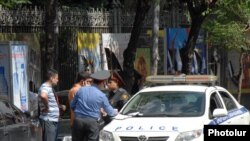Prime Minister Tigran Sarkisian stressed the importance of the “long-awaited measure” at a weekly session of his cabinet. He said the police will be able to better enforce road safety by quickly detecting and punishing traffic offenders.
Sarkisian told ministers that the cameras will also minimize physical contact between police officers and motorists. “Corruption risks will decrease as a result,” he said, according to a government statement.
The statement added that 10 cameras will be installed at major street intersections in Yerevan and another 15 on highways outside the capital by the end of this year. The total number of such devices is to reach 280 by 2017.
Artur Osikian, a deputy chief of the national police service, revealed at a news conference that the centralized road surveillance system will be operated for the next 25 years by the Swedish company Sensys Traffic. He said it recently won an international tender called by the Armenian government.
News agencies quoted Osikian as saying that Sensys Traffic has pledged to invest about 10 million euros ($14 million) in the traffic monitoring system. He said the company will recoup its investments by receiving at least half of the proceeds from speeding fines to be slapped by police officers.
The Armenian traffic police have until now used only mobile radars and digital cameras placed in cars patrolling streets and highways. Officers are required to turn them on while on duty.
The equipment was installed in virtually all patrol cars two years ago. Although bribery among police officers remains commonplace, motorists say that their chances of being unfairly fined have fallen considerably since then.
The equipment purchase was part of a five-year government plan to make Armenian roads safer for car drivers and pedestrians. It was launched in August 2009 and involved a significant toughening of fines as well as a successful crackdown on the widespread and long-standing non-use of safety belts in the country.
The police also began fining pedestrians crossing streets in unauthorized locations. They had for decades turned a blind eye to these practices.
Official statistics show the number of traffic accidents and resulting casualties falling since 2009. According to the police, 289 people died in such accidents last year, down from 325 fatalities reported in 2009.




